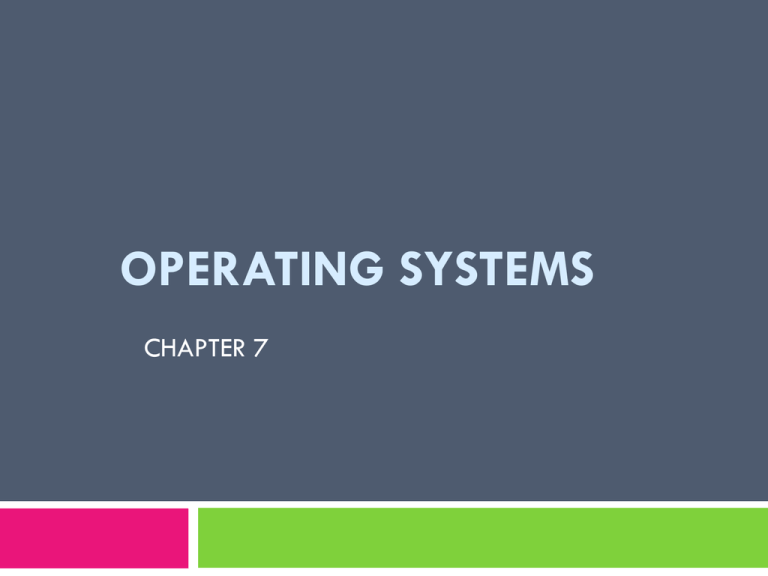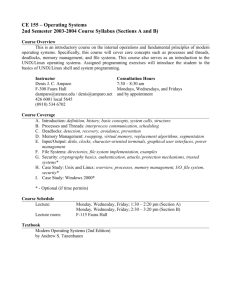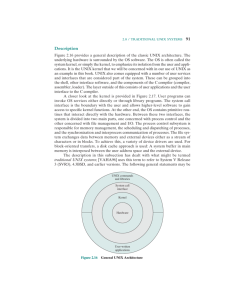Operating Systems
advertisement

OPERATING SYSTEMS CHAPTER 7 Chapter Outline Introduction: Operating System definition Bootstrap process Evolution A Survey of Operating Systems UNIX LINUX Windows 7.1 INTRODUCTION Introduction A computer is a system composed of two major components: hardware and software. Introduction Computer software is divided into two broad categories: Operating System definition An operating system is complex, so it is difficult to give a simple universal definition. Instead, here are some common definitions: An operating system is an interface between the hardware of a computer and the user (programs or humans). Operating System definition An operating system is a program (or a set of programs) that facilitates the execution of other programs. An operating system acts as a general manager supervising the activity of each component in the computer system. Operating System definition An operating system is an interface between the hardware of a computer and the user (programs or humans) that facilitates the execution of other programs and the access to hardware and software resources. Operating System definition Two major design goals of an operating system are: 1. 2. Efficient use of hardware. Easy of use of resources. Bootstrap process The Operating System is responsible for loading other programs into memory for execution. However, the operating system itself is a program that needs to be loaded into the memory and be run. How is this problem solved ?! Bootstrap process 1. 2. The solution is a two-stage process: A very small section of memory is made of ROM and holds a small program called the bootstrap program. When the computer is turned on, the CPU counter is set to the first instruction of this bootstrap program and executes the instructions in this program. When loading is done, the program counter is set to the first instruction of the operating system in RAM, and the operating system is executed . Bootstrap process 7.2 EVOLUTION EVOLUTION Operating Systems have gone through a long history of evolution : 1. 2. 3. 4. 5. 6. Batch systems Time-sharing systems Personal systems Parallel systems Distributed systems Real-time systems 1. Batch operating system It were designed in the 1950s to control mainframe computers. At that time, computers were large machines that used punched cards for input, line printers for output and tape drives for secondary storage media. Each program to be executed was called a job. A programmer who wished to execute a job sends a request to the operating system. Operating system during this era were very simple . 2. Time – sharing systems To use computer system resources efficiently, multiprogramming was introduced. The idea is to hold several jobs in memory at a time, and only assign a resource to a job that needs it on the condition that the resource is available. Time sharing: resources could be shared between different jobs, with each job being allocated a portion of time to use a resource. 3. Personal systems When personal computers were introduced, there was a need for an operating system for this new type of computer. During this era, single-user operating systems such as DOS (Disk Operating System) were introduced. 4. Parallel systems The need for more speed and efficiency led to the design of parallel systems: multiple CPUs on the same machine. Each CPU can be used to serve one program or a part of a program, which means that many tasks can be accomplished in parallel instead of serially. The operating systems required for this are more complex than those that support single CPUs. 5. Distributed systems Networking and internetworking have created a new dimension in operating systems. A job that was previously done on one computer can now be shared between computers that may be thousands of miles apart. Distributed systems combine features of the previous generation with new duties such as controlling security. 6. Real – time systems A real-time system is expected to do a task within a specific time constraint. They are used with real-time applications, which monitor, respond to or control external processes or environments. 7.4 A SURVEY OF OPERATING SYSTEMS a survey of operating systems 1. 2. 3. There are three operating systems that are familiar to most computer users: UNIX. Linux. Windows. UNIX UNIX was originally developed in 1969 by Thomson and Ritchie . UNIX has gone through many versions since then. It has been a popular operating system among computer programmers and computer scientists. It is a very powerful operating system . UNIX UNIX is a multiuser, multiprocessing, portable operating system. It is designed to facilitate programming, text processing and communication. UNIX 1. 2. 3. 4. UNIX consists of four major component : The kernel The shell Standard set of utilities Application programs Linux In 1991, Linus Torvalds, a Finish student at the University of Helsinki at the time, developed a new operating system that is known today as Linux. The initial kernel, which was similar to a small subset of UNIX, has grown into a full-scale operating system today. The Linux 2.0 kernel, released in 1997, was accepted as a commercial operating system: it has all features traditionally attributed to UNIX. Windows NT/2000/XP In the late 1980s Microsoft, under the leadership of Dave Cutler, started development of a new single-user operating system to replace MS-DOS (Microsoft Disk Operating System). Windows NT (NT standing for New Technology) was the result. Several versions of Windows NT followed and the name was changed to Windows 2000. Windows XP (XP stands for eXPerience) was released in 2001. We refer to all of these versions as Windows NT or just NT. Windows NT/2000/XP






